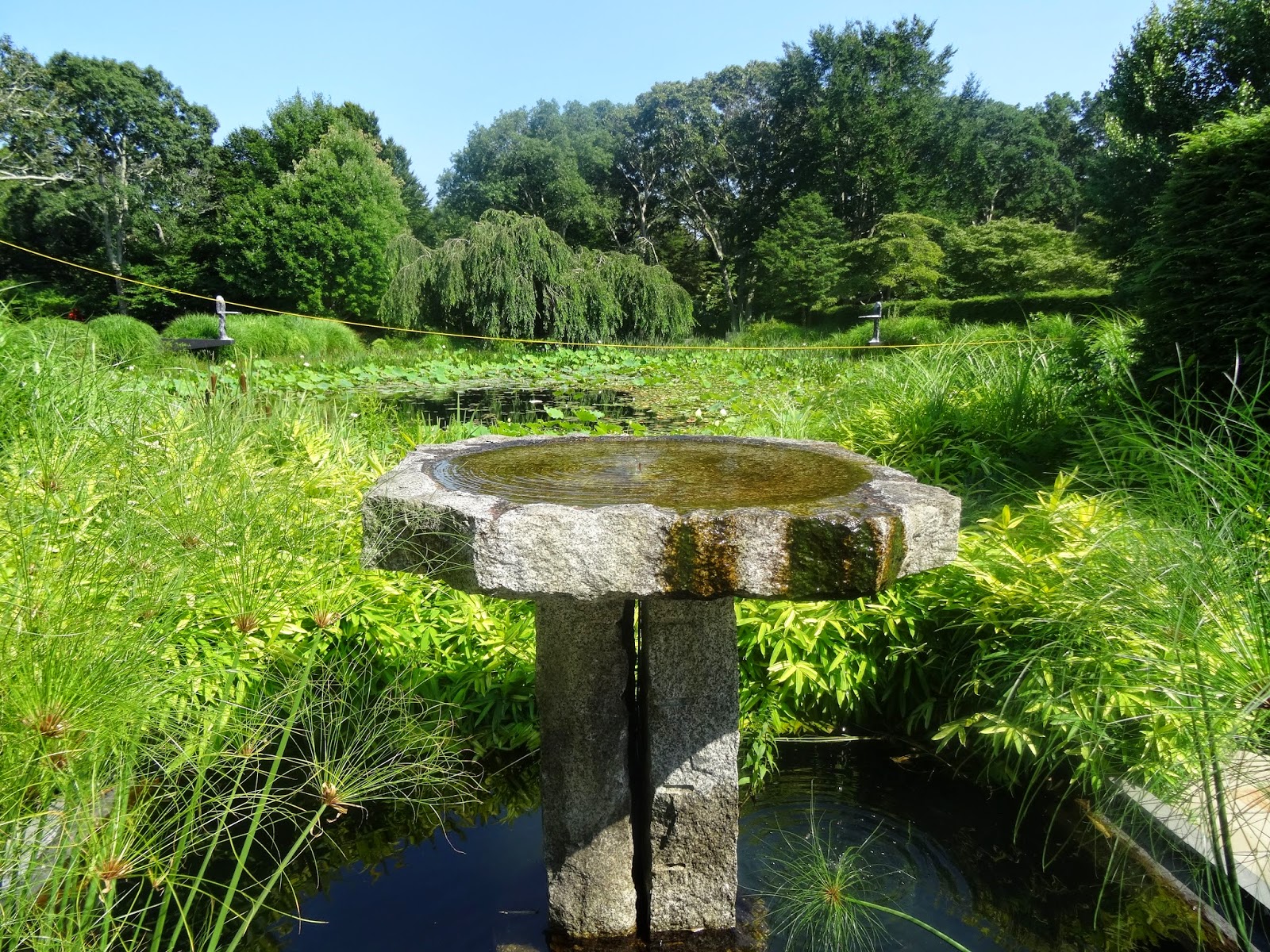LongHouse Reserve.
It was my second visit, and a much more interesting one than the first. One reason is that this time the visit was made with a docent to tell us the many stories of each part of LongHouse.
Our docent, James Zajac, was exceptionally well informed - not so surprising, perhaps, if you know that he is also a Trustee of the foundation.
The venue was well chosen for the purposes of a mini-reunion. This was one of several Wellesley mini-reunions in the run-up to the class's 50th Reunion in 2015-2016.
 |
| James Zajac, our Docent and a LongHouse Trustee. |
 |
| The Gateway Bell (#4). Susan Ritten- house '66 wields the Docent's mallet. |
Professor Takaezu was named a Japanese "national treasure" for her work with ceramics before she went to Princeton to teach in Visual Arts for 25 years. She died at the lucky (in Asia) age of 88 in 2011. She won Princeton's three highest awards in the humanities, and an honorary doctorate. One of her students was Brooke Shields, who complied with the course requirement that ceramics students had to keep their nails short.
 |
| Peter's Pond (#16), Ground Level. |
On the LongHouse map, Peter's Pond is shown in blue but in fact it is almost entirely covered by lily pads and other green plants. The view we had of the pond at ground level is shown at right.
 |
| Alice Tepper Marlin '66 looks at our docent who appears giant-like in the Red Garden (#17). |
The photo at left captures the effect, but it would be clearer with 3D or with multiple photos showing the change in size as a person walks toward the smaller posts.
Among the sculptures, the story behind Yoko Ono's colors-be-damned life-size Chess Set (#26) was particularly inspiring once the story behind it emerges like Brigadoon from the mist.
If you look at the photo, note there are no black pieces and no black squares on the chess board.
 |
| The Yoko Ono Chess Set (#26) is about half the size of a tennis court. Why no black pieces? Why no black squares? Did the paint wear off?? |
Yoko Ono is hammering home the point that war is about establishing identities and territories and then fighting over them.
As soon as we recognize that walk under many different colors - we have many IDs - we can deal with attempts to dehumanize other people based on a single ID that they share.
As soon as we understand that we can share our square, peace is possible.
Easier said than done, but... Imagine.
(Losing the colors, by the way, also happens to be an effective way of waging war by the defenders. If the defenders are out of sight or hard to identify, the attackers don't know what to do. That's what Edward II and Edward III found out when they tried to attack Robert the Bruce's Scotland. The outnumbered Scottish defenders under the "Good Sir James Douglas", as he is known on the Scottish side of the border, melted into the woods. They pursued what they called a "secret war". The musclebound American military machine has been subject to the same quandary in the face of a guerrilla or terrorist enemy that has a hidden identity. Where do we go to punish those responsible if we don't know who they are? Do we "round up the usual suspects"?)
 |
| Torii-like Sculpture in front of Peter's Pond (#16), viewed from the terrace of the Pavilion (#34). |
It takes 20 years for a permanently employed family of artisans to build the shrine's replacement. Then the 20-year-old shrine is is torn down, and a new one is started with wood that comes from trees that were specially planted in the sacred imperial woods to mature at the time they are needed.
 |
| Features of a Torii. |
As one would expect of a famed collector of fabrics, the house has an unusual collection of interesting fabrics - and also ceramics, furniture and other objects.
 |
| The map of LongHouse sculptures and sites, available at the entrance (#3). |
 |
| The Dial-In Docent, available 24/7. |
Each story is linked to the number posted at the site, in front of the sculpture or other feature.
For those who are sufficiently expert in cell-phone technology, a bar code is provided at each site that can be read by the phone and will take you directly to the right point in the Dial-In Docent's repertoire.
There were countless different forms of seating, most of which could be utilized for a break in the walk. There is a rest room at the entrance (#3), to which one can return if necessary during one's visit.
Don't miss this gem of a place. It is rated by Trip Advisor as the #1 attraction in East Hampton - but then the Ocean is not included in the rating (Main Beach is, and ranks below LongHouse).

Postscript
I hope to be around for the 50th Reunion of the Wellesley Class of 1966 in mid-2016.
Here's a photo at right of the head of the parade at the last Wellesley Reunion I went to.
Note the two flamingoes near the center of the photo. There is a long story explaining why the flamingo is the class mascot.


No comments:
Post a Comment